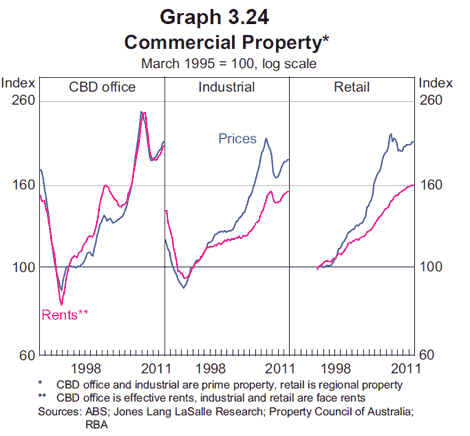Commercial property returns improving but still below pre-GFC peaks: RBA
The commercial Property Sector continued to improve in late 2011 driven by a drop in office vacancy rates and a rise in office property values and rents, according to the RBA’s latest Financial Stability Review (FSR).
The FSR notes that office property values and rents rose by about 7% over the year, but still remain around 15% below their 2007 peaks on a national basis.
The report notes that office vacancy rates in most capital cities have stabilised or declined moderately since 2009, with larger falls recorded in Perth and Brisbane, where vacancy rates had previously increased more sharply.
“The pick-up in office property prices was evident across most capital cities. Prices and rents in the industrial property market also strengthened, though conditions in the retail property market have been more subdued,” the RBA says.

However, the RBA makes an important distinction between the recent downturn caused by the GFC and past adjustments.
“The adjustment in the commercial property market in recent years was less severe and drawn out than the downturn in the early 1990s: office property values fell by 25% over two years from their late 2007 peak, compared with a 50% peak-to-trough fall over four years in the early 1990s.
“There was a smaller supply overhang this time, and banks appear to have delayed selling some non-performing commercial property assets until conditions improved rather than selling into a depressed market,” the central bank says.
“There were some market segments, however, where stock additions at the peak of the market subsequently put pressure on vacancy rates and rents, especially than in earlier years.
“Lending conditions are said to be particularly tight for residential property developments in Melbourne, given concerns about a possible oversupply of apartments in that city,” says the RBA.
The report notes a slightly better lending environment, with the “quality of banks’ commercial property exposures improved slightly over 2011, but the impairment rate remains above that for banks’ total business lending (5% versus 3%)”.
“Commercial property impairments are about one-half of banks’ total impaired business assets, even though lending to the sector accounts for only about one-third of total business lending,” says the RBA.
It also notes while European banks’ exposure to the Australian commercial property has shrunk by about 60% Asian banks have increased their exposures to the market over the past two years, though from a relatively low base.
The non-bank sector continues to struggle to lend on commercial property.
“Non-bank sources of finance for commercial property remain constrained, with little issuance of commercial mortgage-backed securities in recent years and mortgage trusts’ funds under management continuing to decline,” says the RBA.